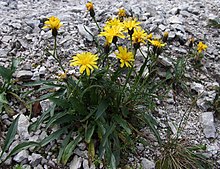Crepis
| Crepis | |
|---|---|
 |
|
| Crepis jacquinii | |
| Scientific classification | |
| Kingdom: | Plantae |
| (unranked): | Angiosperms |
| (unranked): | Eudicots |
| (unranked): | Asterids |
| Order: | Asterales |
| Family: | Asteraceae |
| Tribe: | Cichorieae |
| Genus: |
Crepis L. |
| Species | |
|
about 200, see text |
|
about 200, see text
Crepis, commonly known in some parts of the world as hawksbeard or hawk's-beard (but not to be confused with the related genus Hieracium with a similar common name), is a genus of annual and perennial flowering plants of the family Asteraceae superficially resembling the dandelion, the most conspicuous difference being that Crepis usually has branching scapes with multiple heads (though solitary heads can occur). The genus name Crepis derives from the Greek krepis, meaning "slipper" or "sandal", possibly in reference to the shape of the fruit.
The genus is distributed throughout the Northern Hemisphere and Africa, and several plants are known as introduced species practically worldwide. The center of diversity is in the Mediterranean.
Crepis species are used as food plants by the larvae of some Lepidoptera species including the broad-barred white moth. The fly Tephritis formosa is known to attack the capitula of this plant.
Seeds of Crepis species are an important food source for some bird species.
In Crete, Greece the leaves of Crepis commutata which is called glykosyrida (γλυκοσυρίδα) is eaten raw, boiled, steamed or browned in salads. Another two species on the same island, Crepis vesicaria, called kokkinogoula (κοκκινογούλα), lekanida (λεκανίδα) or prikousa (πρικούσα) and a local variety called maryies (μαργιές) or pikrouses (πικρούσες) have both its leaves and tender shoots eaten boiled by the locals.
...
Wikipedia
